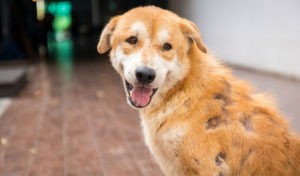 Wrinkly dogs like Pugs are so cute. What’s not so cute? The skin disease that can result from improper care of the skin in those wrinkles. Skin fold dermatitis is a skin condition most common in breeds with pronounced facial, tail, and vulvar folds, though any deep skin fold anywhere in the body can be susceptible to skin fold dermatitis.
Wrinkly dogs like Pugs are so cute. What’s not so cute? The skin disease that can result from improper care of the skin in those wrinkles. Skin fold dermatitis is a skin condition most common in breeds with pronounced facial, tail, and vulvar folds, though any deep skin fold anywhere in the body can be susceptible to skin fold dermatitis.
This condition occurs when skin folds are deep, causing abnormal rubbing and retaining moisture in an area that’s both warm and not well aerated. These conditions are ideal for the overgrowth of normal skin inhabitants like yeast and bacteria. The resulting skin inflammation, called dermatitis, typically leads to a skin infection called pyoderma. Chronic pyoderma is typical in cases of skin fold dermatitis.
Though not a genetic disease, per se, skin characteristics that include wrinkles and deep skin folds are more common in certain breeds. In pets already predisposed to skin fold dermatitis, obesity can exacerbate the condition. Underlying skin disease (such as allergic skin disease) will also aggravate the condition, often severely.
Signs and Identification
Skin fold dermatitis is easily identified as typically hairless (alopecic), reddened, and malodorous areas of folded skin or creases/wrinkles. In the case of deep facial folds (typical of brachycephalic dogs and cats), brown staining of facial fur (secondary to components in tears) can make these folds look more pronounced.
Tail fold dermatitis (typical to dogs with corkscrew tails), when especially severe, can lead to deep, severe infections. These deep tail folds are typically identified by probing the tail base with a cotton-tipped swab to determine its depth.
Vulvar tail fold dermatitis can occur in female dogs that have excess skin folds around their private area. Urinary tract infection can occur as a consequence of vulvar skin fold pyoderma.
Affected Breeds
All brachycephalic (short-headed, flat-nosed) breeds that have facial folds are similarly predisposed to skin fold dermatitis of this area (Bulldogs,Pugs, Shih Tzus, etc). “Wrinkly” dogs like Shar-Peis and bloodhounds are also affected. Likewise, dogs with corkscrew tails, English bulldogs for example, can be affected.
Cats that have facial folds, such as Persians, or are overweight (creating more skin folds) are also at risk.
Treatment
Treatment for skin fold dermatitis involves cleaning of the affected areas and frequent use of topical or systemic (oral or injectable) antimicrobial medications to manage the resulting pyodermas.
Surgical intervention may be recommended for moderate to severely affected animals. Removing the abnormal skin folds will, in many cases, yield a complete cure.
Treating any underlying skin disease and maintaining a healthy body weight can reduce the severity or even eliminate skin fold dermatitis.
Prevention
To help keep your pet free of skin fold dermatitis, watch your pet’s weight, and carefully clean the skin folds regularly; be sure to used products that are approved for pets and (if facial folds are present) are safe to use around the eyes and face. Also, work with your vet on treating any skin conditions.




